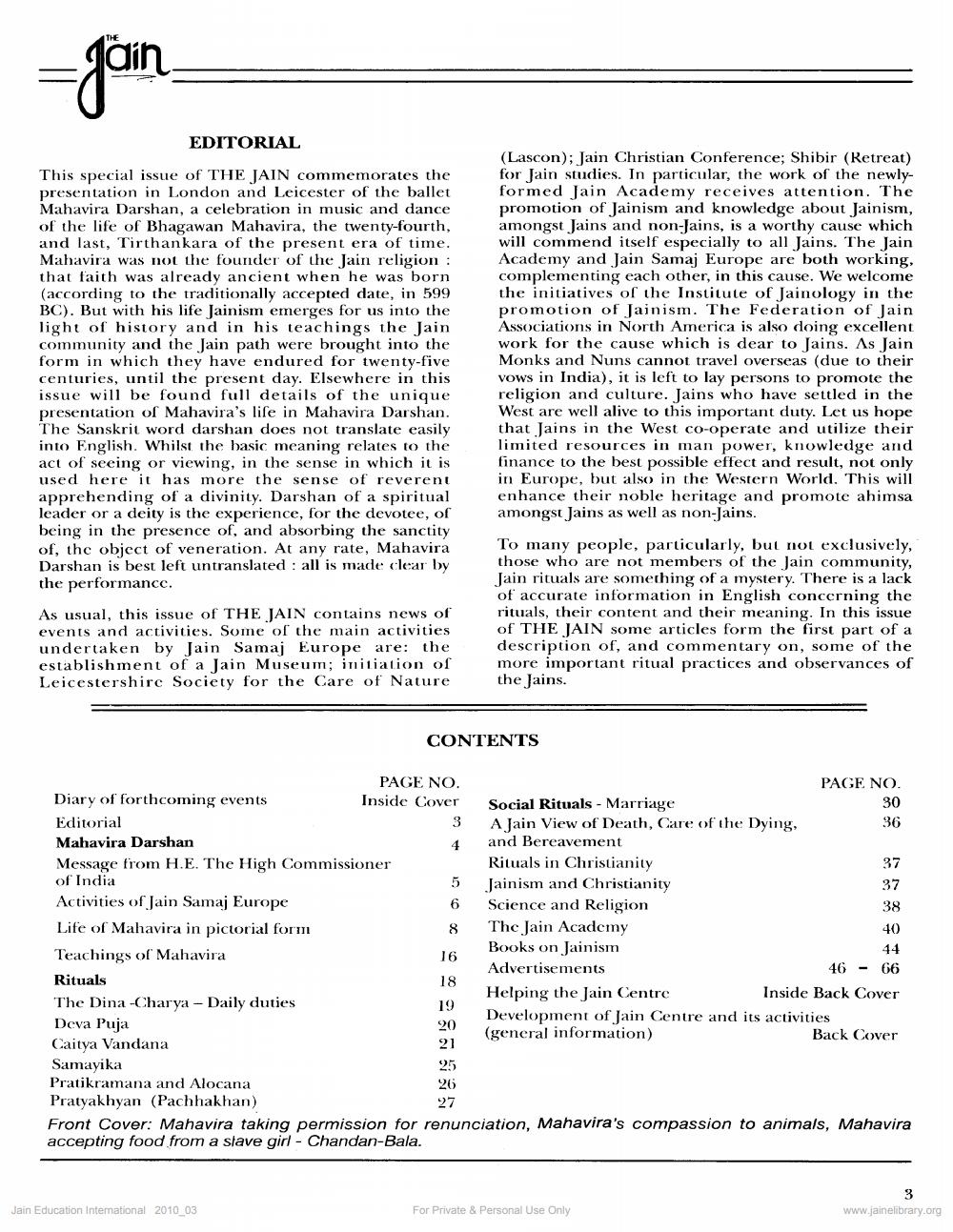Book Title: The Jain 1992 04 Special Issue Author(s): Natubhai Shah, Vinod Kapashi Publisher: UK Jain Samaj Europe View full book textPage 3
________________ THE =Jain EDITORIAL This special issue of THE JAIN commemorates the presentation in London and Leicester of the ballet Mahavira Darshan, a celebration in music and dance of the life of Bhagawan Mahavira, the twenty-fourth, and last, Tirthankara of the present era of time. Mahavira was not the founder of the Jain religion : that faith was already ancient when he was born (according to the traditionally accepted date, in 599 BC). But with his life Jainism emerges for us into the light of history and in his teachings the Jain community and the Jain path were brought into the form in which they have endured for twenty-five centuries, until the present day. Elsewhere in this issue will be found full details of the unique presentation of Mahavira's life in Mahavira Darshan. The Sanskrit word darshan does not translate easily into English. Whilst the basic meaning relates to the act of seeing or viewing, in the sense in which it is used here it has more the sense of reverent apprehending of a divinity. Darshan of a spiritual leader or a deity is the experience, for the devotee, of being in the presence of, and absorbing the sanctity of, the object of veneration. At any rate, Mahavira Darshan is best left untranslated: all is made clear by the performance. As usual, this issue of THE JAIN contains news of events and activities. Some of the main activities undertaken by Jain Samaj Europe are: the establishment of a Jain Museum; initiation of Leicestershire Society for the Care of Nature Diary of forthcoming events Editorial Mahavira Darshan Message from H.E. The High Commissioner of India Activities of Jain Samaj Europe Life of Mahavira in pictorial form Teachings of Mahavira Rituals The Dina -Charya - Daily duties Deva Puja Caitya Vandana Samayika Pratikramana and Alocana Pratyakhyan (Pachhakhan) PAGE NO. Inside Cover Jain Education International 2010_03 CONTENTS 3 4 5 6 8 ༤༤༤རྨེ་iསེལ 20 (Lascon); Jain Christian Conference; Shibir (Retreat) for Jain studies. In particular, the work of the newlyformed Jain Academy receives attention. The promotion of Jainism and knowledge about Jainism, amongst Jains and non-Jains, is a worthy cause which will commend itself especially to all Jains. The Jain Academy and Jain Samaj Europe are both working, complementing each other, in this cause. We welcome the initiatives of the Institute of Jainology in the promotion of Jainism. The Federation of Jain Associations in North America is also doing excellent work for the cause which is dear to Jains. As Jain Monks and Nuns cannot travel overseas (due to their vows in India), it is left to lay persons to promote the religion and culture. Jains who have settled in the West are well alive to this important duty. Let us hope that Jains in the West co-operate and utilize their limited resources in man power, knowledge and finance to the best possible effect and result, not only in Europe, but also in the Western World. This will enhance their noble heritage and promote ahimsa amongst Jains as well as non-Jains. 25 26 27 To many people, particularly, but not exclusively, those who are not members of the Jain community, Jain rituals are something of a mystery. There is a lack of accurate information in English concerning the rituals, their content and their meaning. In this issue of THE JAIN some articles form the first part of a description of, and commentary on, some of the more important ritual practices and observances of the Jains. Social Rituals - Marriage A Jain View of Death, Care of the Dying, and Bereavement Rituals in Christianity Jainism and Christianity Science and Religion The Jain Academy Books on Jainism Advertisements PAGE NO. 30 36 37 37 38 40 44 46 66 Inside Back Cover Helping the Jain Centre Development of Jain Centre and its activities (general information) For Private & Personal Use Only Front Cover: Mahavira taking permission for renunciation, Mahavira's compassion to animals, Mahavira accepting food from a slave girl - Chandan-Bala. Back Cover 3 www.jainelibrary.orgPage Navigation
1 2 3 4 5 6 7 8 9 10 11 12 13 14 15 16 17 18 19 20 21 22 23 24 25 26 27 28 29 30 31 32 ... 68
